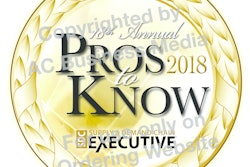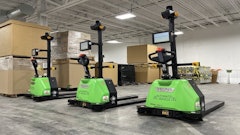
The annual Best Fleets to Drive For program is dedicated to uncovering the best workplaces and best practices in the North American trucking industry. Created by CarriersEdge, in partnership with the Truckload Carriers Association, the program evaluates more than 100 nominated fleets and collects thousands of driver surveys each year. The resulting data provides a clear picture of what’s working at fleets of all sizes.
The nomination and evaluation process is rigorous. Nominated fleets must gather many driver surveys and data from all departments and are evaluated across a range of performance criteria. The evaluation identifies those companies most successful in creating a work environment in which drivers feel valued. More than half don’t make it to the final round. Those that do demonstrate that they have strong management and employee teams with the ability to communicate and collaborate effectively. Finalists that earn the coveted Best Fleets to Drive For honor show mastery in developing recipes for success. Last year, the Top 20 Best Fleets featured several refrigerated carriers, including Nussbaum Transportation and Grand Island Express. Grand Island Express won the best overall honor in the small fleet category.
Each year, CarriersEdge updates the corporate questionnaire and driver survey to reflect new ideas and trends discovered in the previous year. This process captures best practices as they’re emerging, ensuring winners always reflect the latest innovations. As they’ve been examining nominations for 2018, innovations are breaking down into two main themes—expanding communication and demonstrating respect for drivers.
Expanding Communication
Gone are the days when an open-door policy and suggestion box represented the foundations for communication with drivers. Over the past few years, the transportation industry’s Best Fleets have continually been working on new ways to keep drivers in the loop and engaged. This year, fleets continue those efforts with:
- Townhalls—Moving away from the traditional weekly meetings, the most innovative fleets deliver documents and policy updates through interactive townhalls over the web or by satellite. For example, Grand Island Express holds monthly meetings with drivers through a web conferencing tool. Drivers participate by using a laptop, PC or mobile device or by calling in through a conference line when they don’t have access to the internet. Drivers can also view a full recording of the meeting if they can’t attend during the live session. Grand Island Express finds that by using web conferencing, drivers can participate in more collaborative and interactive discussions. And since drivers can view the meeting later, they can stay in the loop and still meet their schedules.
- Committees—While driver committees have been around for years, many fleets assign committees mandates, establish processes for keeping their work fresh, and then regularly evaluate their effectiveness. More advanced fleets treat their driver committees like town councils. They ensure all constituencies are represented, hold elections among drivers to determine their makeup, and even set term limits. To offer greater transparency, some fleets transmit committee meetings via the web and post minutes on their intranet sites.
- Vehicle Spec’ing—Fleets involved in the Best Fleets program uniformly provide newer, higher end equipment to drivers, with the average age of their fleets rarely exceeding two years. With much equipment spec’ing to be done, more and more fleets involve drivers through driver committees or by collecting their feedback.
- Equipment Management—Regular maintenance beyond the routine oil changes and inspections is just as important as acquiring new gear. That’s why participating fleets have been developing increasingly more elaborate communication processes between drivers and shops to gain optimum efficiency. For example, fleets gain increased automation in their maintenance shops by connecting their trucks’ ECMs to their shop maintenance management systems.
Demonstrating Respect
Everyone says they respect their drivers, but since actions speak louder than words, Best Fleets pursue new ways to demonstrate respect regularly. Some of the less obvious examples include:
- Hometime—Best Fleets know drivers covet hometime, particularly during those must-attend events such as weddings, anniversary celebrations, graduations and birthdays, including quinceaneras. With their drivers on the road so much, Best Fleets are implementing new policies to focus on their accuracy in getting drivers home on time and then measuring their success.
- Recognition—Moving beyond the traditional annual recognition banquets, fleets like Nussbaum Transportation hold events more frequently throughout the year. Plus, they recognize drivers not only for the safety milestones and driver of the month honors, but also for various anniversaries, positive customer feedback and other accomplishments such as high fuel efficiency milestones. And the large refrigerated carrier makes it a point to return drivers to their home terminals for those ceremonies, which are recorded and posted on the company’s YouTube channel and Facebook page.
- Coaching—Over the past four years, driver coaching has changed. Previously, fleets provided coaching and mentoring programs for new hires, or drivers in finishing programs, but only for a short time. Now, coaching continues for a year or more, and in some cases, it never completely stops. Also, with a greater prevalence of dashcams, coaches have access to more data, improving their overall effectiveness.
- Everyday Equality—Best Fleets recognize how locking drivers out of the building and making them use a driver window to speak to co-workers can easily undermine great driver programs. Consequently, they are opening up their terminals, ensuring drivers have the same access as other staffers. HR policies, benefit packages, and facilities are also being updated so drivers receive equal or even preferential treatment.
Just looking at the eight areas above, it’s easy to see how much and how quickly the industry is changing. While these activities barely registered in the survey results CarriersEdge saw five years ago, they’re becoming more commonplace now. As always, it will be fascinating to see what this year’s crop of Best Fleets are doing for their drivers, and how those chosen for the 2018 Best Fleets to Drive For honor raise the bar for innovation.



















